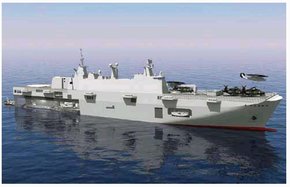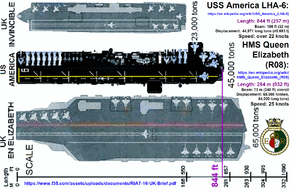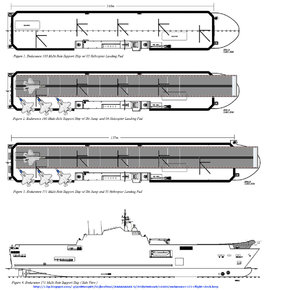A couple of points of distinction. First, the
Bay-class HMAS Choules is a Landing Ship Dock (LSD), not a Landing Platform Dock (LPD) like the USN's
San Antonio-class or the RN's
Albion-class. The second is that HMAS Choules brings a somewhat different capability to the amphibious operations table than the
Canberra-class LHD does, so stating or advocating to replace the
Bay-class with another
Canberra-class, or especially a modified
Canberra-class, does not really make sense from a planning perspective IMO.
Per the RAN page on the LHD's, up to 110 vehicles total can be transported between the light and heavy vehicle decks, depending on size and configuration. At the same time, the RAN page for HMAS Choules indicates that it can transport up to 150 light vehicles, or 32 M1A1 Abrams MBT's. What that suggests to me is that the LHD's are designed to transport and then land most of the troops and with vehicle support, while the LSD is intended to land mostly vehicles. From my recollection of discussions held on the forum at the time the LHD decision was announced, the planning centered around an LHD and LSD working together on an op, or an LHD establishing an initial landing, with additional kit to be brought in by the LSD afterwards.
Also, while the LHD's can indeed hangar up to 18 medium helicopters, that is only by using both the hangar and light vehicle deck. If the light vehicle deck is occupied by helicopters (or other aviation assets) then either no light vehicles are embarked, or they are relocated to the heavy vehicle deck and occupy space that otherwise could be used by a heavy vehicle.
With the RAN (and thus the ADF) being now reduced to just three ocean-going amphibious/sealift vessels, I do believe more vessels are needed, especially given what the current tempo of operations and exercises have been for them. The same tempo of operations and training/exercises is also a significant part of why I feel trying to use the LHD's, or even an additional modified version of one, to embark and operate F-35's, would be a bad idea.
If the ADF/RAN did actually have three
Canberra-class LHD's, that should be enough to guarantee an LHD would be available for if not already on a deployment, with another in a maintenance cycle, and the third either in a pre-deployment workup, training, or post-deployment recovery phase. If the RAN tried to have one in training for amphibious ops, with a second training for F-35B ops, that would make it difficult for the third LHD to meet both the deployment and it's own maintenance requirements.
Side note, looking at the Spanish Armada page for the Juan Carlos I
here, it does indeed appear that the configuration between the Spanish and RAN vessels are quite different. The JC1 can operate up to 30 medium/heavy helicopters, or up to 12 F-35B/AV-8B+ STOVL jets, while a
Canberra-class can hangar up to 18 medium helicopters (again, using both the hangar and adjacent light vehicle deck) with landing spots on the flight deck for an additional six medium helicopters, or four CH-47 Chinook helicopters. What that indicates to me, is that the Spanish LHD has a greater aviation capability than the RAN version, and even with that apparently greater capability, at best a dozen STOVL jets can be embarked.
From my POV, a dozen embarked F-35B's is not really worth the loss of the other aviation capabilities and/or the vehicle space aboard a RAN LHD unless there were other aviation assets to provide complimentary capability coverage to make the F-35B operations worthwhile. After all, if the embarked F-35B's were to be expected to provide a CAP/air defence capability, plus a strike/CAS capability, more than a dozen jets would be required for anything other than extremely short operations. After all, at least six (likely more IMO) jets would be required to enable a two-jet CAP flight aloft 24/7.
For those who have not realized it yet, I am not fundamentally opposed to Australia developing and having a fast jet or fixed-wing aircraft carrier capability, since that could provide so many potential options to Australia in terms of defence and foreign policy. What I do not want to see, is Australia "robbing Peter to pay Paul" by re-directing resources away from a currently existing, much utilized and lMO already under-resourced capability, so that a new capability can be kind of raised. IMO it would be better for fixed-wing carrier ops to be properly resourced rather than competing with the ADF's amphibious forces for use of the LHD's.




